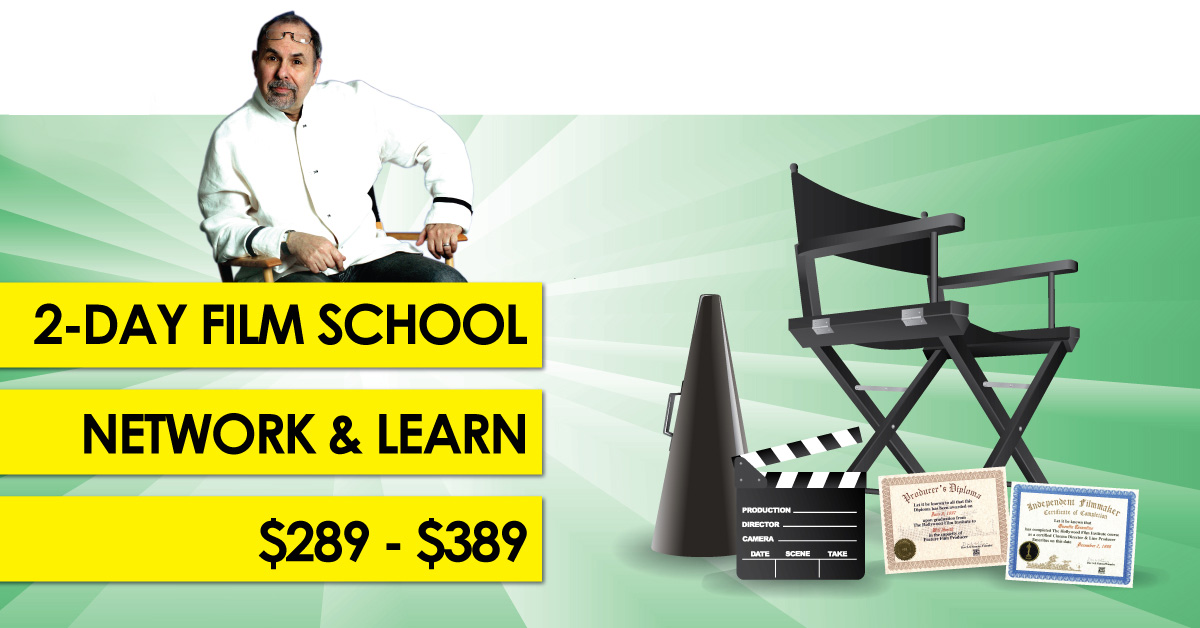MOVIE MONEY (Part 7): BUDGET FOR INDY MONEY (This method is so simple )
by Dov S-S Simens on October 30, 2015
THE INDEPENDENT BUDGET vs THE STUDIO BUDGET
WARNING! Want to succeed as a Filmmaker? Then do not budget the for a Studio feature film when planning to make an Independent feature film.
Huh? The Studio Method or the Independent Method? Yes, there are 2 ways to approach the preparation of a Budget for a feature film and they are extremely different.
If you are planning Independent Financing to fund your project do not prepare a Studio Budget. Likewise, if you are planning a Studio Feature, with names, guilds & unions, then do not prepare an Independent Budget to bring to a studio like Warners, Paramount, Sony or Disney.
Permit me to explain: The first, the “Studio Method” (aka: the Correct Way, as taught at UCLA, USC, NYU or AFI), is where you take the script, purchase a budgeting program (Easy Buget, MovieMagic, Gorilla6, etc, from the web’s Writers Store) or simply get a blank 30-50 page budget form package, ask 100s of questions and fill in every Line Item “The Right Way”.
The second, the “Indy Method” (aka: “the Wrong Way”), is where you literally just pick a number, a dollar amount of how much money you believe you can secure (be honest, be realistic) from not Hollywood but your friends, family, relatives or possibly a “crowd”. The Indy Method then becomes… “first start with the Budget then back-into-it”.
All I know is that when as a first-timer doing a budget “the Right Way”, the Studio Method, it will always have you obtain a budget of $2-$100 Million… to make your movie… “The Right Way”.
QUESTION: Who the hell is going to give you, a first-timer, with no marketable value to your name, $2 Million to $100 Million? Be honest. Who?
ANSWER: Nobody. That is unless your dad is a billionaire like an Ellison or a Pritzker or maybe a Sheik (Oil is $43/barrel today. No more Sheiks)
FACT: “The Right Way” (The Studio Method) of preparing a budget, although called “the right way” doesn’t work. For it always get you a dollar amount that it is so large that you are never going to get that money. However, preparing a budget “The wrong way” (The Independent Method), is the realistic & practical way. Thus, “the wrong way” is first pick-a-number a-dollar-amount (total guesstimate, but based on reality) of how much money you can literally scam up from friends, relatives, a couple of dentists, or the “crowd”. It might be $5K, $10K, $28K even $100K, possibly $200K-$300K but I doubt it… and then you back-into-it.
Voilla! The wrong way (Indy Method) works and the right way (Studio Method) doesn’t work for your first independent feature film budget.
Now that you have your approach down allow me to forward you some nuts-and-bolts information on how to think “what-will-this-cost”.
A typical feature budget has 30 to 40 categories, anywhere from 250 to 300-plus line items, and 400-800 “details” within those items. How does anyone figure all that out?
The good news is that you don’t have to start from scratch, or get it right the first time. The process is less mysterious than it seems.
Studio Method or Independent Method: Let’s now go step-by-step or line item by line item and outline the budgeting thought process…
The Breakdown
First, you need to understand your script at an atomic level, so break it down. Start with these steps:
- Jot down each separate shooting location in the script. The bathroom, bedroom and living room of the same family house can count as one location. The outside of the house, however, should count as a separate location (i.e. you may have to shoot this somewhere else).
- Write down each speaking role and what scenes they appear in.
- Determine how many “script days” your story takes place in, and over how long a time period. Before Midnight takes place in one day; X-Men: Days of Future Past occurs over several days, spread out over several decades. This gives you a very rough idea of how many wardrobe changes and seasonal or period adjustments (snow, rain, fog, falling leaves, production design changes) you need to account for.
- Determine how many scenes you have that require a lot of extras: sporting events, city streets, classes, dances, bars, weddings, funerals, and other major social occasions.
Next, create a breakdown sheet for each scene in your script. The breakdown sheets should contain (at minimum):
- Scene Numbers
- Interior or Exterior
- Set (the room or area the scene is set in)
- Location (the larger area, house or building that the set is in)
- Short Description
- Time of Day
- Scene Length
- List of Cast
- List of Extras
- Picture Vehicles
- Stunts
- Special Equipment Needs
- Pets/Effects/Special Makeup
- Props
- Set Dressing
Analyzing the script this way will give you a better sense of its true scope. Low-budget indie films can be long on one or two items, but not on everything.
Setting Parameters
Once you’ve broken down the script, it’s time to make key assumptions for your production. These will guide you through the rest of the process.
- Target Budget
This is what you think the film should be made for—or what you fervently hope you can do it for. (It may have very little to do with reality.)
SAG/Union Agreements
The only union you’re likely to be dealing with on a low budget film will be SAG-AFTRA, unless one of your key crew members is union, or if your budget is over $2 million. SAG specifies certain minimum rates, overtime pay, health/pension/welfare payments, and other rules that you have to abide by. Even if your budget is tiny, you should consider going SAG, or you might run into trouble with casting.
BUDGET: SAG Union Shoot or NON-SAG Indy Shoot
SAG has a rate structure built into its various agreements, based on the limits of a film’s budget:
| Agreement |
Film’s Budget Limit | Minimum | Real Rate* |
| Student Film | $35K / 35 min. student producer |
||
| Short Film | $50K / 35 min. | $0 | $0 |
| Ultra Low Budget Agreement (ULBA) | <$200K | $100/day for 8 hours |
$270/day |
| Modified Low Budget Agreement (MLBA) | $625K | $268/day $933/week |
$723/day $2,416/week** |
| MLBA Diversity Incentive * | <$937.5K | Same as MLBA | |
| Low Budget Agreement (LBA) | <$2.50M | $504/day $1752/week |
$1359/day$4,538/week** |
| LBA Diversity Incentive * | <$3.75M | Same as LBA | |
| Basic | >$2.50M |
* The diversity incentive gives you a higher budget “ceiling,” but only if 50 percent or more speaking roles are cast with women, people of color, seniors, or people with disabilities.
** The weekly “real rates” are derived from a pro-rated hour rate based on 44 hours (instead of 40). Also, the “real weekly total” assumes a 5-day week.
(All totals are rounded up to the nearest dollar.)
The “real rate” includes the following (using the ULBA as an example):
| Base Rate | $100.00 | |
| 4 hours of overtime per day at 1.5x the hourly rate | 4 * 1.5 * $12.50 | $75.00 |
| 10% fee to cover the actor’s agent/manager (this is a courtesy but pretty customary) |
(100 + 75.00) * 10% | $17.50 |
| Subtotal (due to the actor) | $192.50 | |
| 17.3% of above due to the SAG Health/Pension/Welfare Fund | ($192.50) * 17.3% | $33.31 |
| 21% Estimated federal and state payroll fringes (including Social Security, Medicare, federal and state unemployment, disability) | ($192.50) * 21% | $40.43 |
| 2% Payroll company service fee (estimated) | ($192.50) * 2% | $3.85 |
| Total | $270.09 |
So you either want to shoot your film for $200K (under the ULBA) or $625K (under the MLBA), but not $300K, since you’d be in a higher-budget SAG category, which would leave you less money for other items in your budget.
(Note: Stunt coordinators do not use the rates outlined above. Their base rate has recently changed as part of the new Basic Agreement. For details, contact SAGIndie.)
- Format and Camera
Shoot on the camera you can truly afford. Good production design, lighting, and sound will matter more to your tablet-viewing audience than shooting on 4K.
BUDGET: Camera, Lens, Crew (CO, 1AC, 2AC & DIT). Monitor & Expendables

Your choice of format affects other departments, and can result in different prices/considerations for:
- Storage for your camera masters, backup camera masters, picture edit, sound edit, VFX, music, and conform reels. 4K RAW takes up a lot more room than ProResHD 422.
- Lighting and grip: Digital cinema cameras are more sensitive in some ways than film, which means you can work with a smaller lighting package, but each model handles light differently. Your grip needs are different, as well—the overhead rig that can handle the weight of a Canon 5D may not be able to take the load of a Sony F55.
- Camera personnel: You typically need a bigger crew for a 35mm, Red and Alexa rig than for a DSLR or Blackmagic camera.
- Transportation: Bigger cameras require more shelf space, sometimes requiring a larger vehicle.
- Editing workflow: Your editor may need a faster computer to handle certain footage. You will probably have to transcode the footage, as well.
- Syncing: Who’s syncing the sound to your picture? Or are you shooting single source?
- Camera rentals or purchases: It’s tempting to buy. You can amortize the purchase over several projects, and you can shoot whenever you want. But today’s hot model is tomorrow’s doorstop, so be careful. Don’t forget to factor in other items, such as extra cards, an onboard monitor, cables, batteries, support.
- Crew Size
There are three basic categories of crew size, each with its pros and cons.
- 2 to 18: With this run-and-gun size, everyone does a couple of jobs, but you can move very fast.
- 30: This crew can be too big and not big enough. But it can handle larger-scale projects (big crowd scenes, production-design heavy scripts) well.
- 70+: Full-size, with all the departments represented. Able to handle most situations, but slow-moving. Requires a good production team to manage.
Your crew size is determined by your target budget, script, shooting philosophy, and management skills. Would you rather shoot for more time with a smaller crew? For films made for under $200K, the run-and-gun crew makes the most sense.
- Distribution Plan
BUDGET: Festival DCP, Social Media, Facebook, Publicist, Posters, One-Sheets

Illustration by: Wesley Bedrosian
It used to be that production costs ate up your budget. Now it’s distribution and promotion. Distributors have retreated from providing a lot of things, such as: trailers; music and effects mixes (for foreign distribution); closed captioning, subtitles, and timed dialogue lists; mastering, encoding, duplication for DVD, Blu-ray, DCP and other formats; marketing materials, like posters, postcards, ads, press releases, promotional events, and artwork. So you have to. Come up with as detailed a distribution plan as you can—yes, right now. This will also help you sell your film to investors.
- When and Where You Shoot
If you’re shooting far away from home, you’ll need to transport, feed, and lodge your crew and cast, or count on hiring local help.
Ideally, the time of year in the script will match your shoot dates. But if your script is set outdoors and you’re shooting in December (during the shortest days of the year), you may have to add additional days to the schedule.
If you’re shooting in the summer, you have to keep everyone cool when they’re not on set. Add water, iced tea, Gatorade, and coolers to the craft budget, and buy cheap box fans. If you’re shooting in the winter, find a place to keep everyone warm. You may have to rent tents, heaters, and industrial-size coffeemakers.
Schedule
Now, create a schedule, preferably one reasonably efficient, based on the breakdown and your assumptions. Here are some brief pointers:
- Consolidate location and actor days as much as possible
- Get your exteriors out of the way first
- Start on days and end on nights
- Start small and end small
- The more complex a scene (stunts, extras, actors, effects, camera moves), the longer it will take to shoot
- Long dialogue scenes run longer than the official scene “length”
- Try to keep the page count per day reasonable (eight pages is a lot)
The First Draft
Start at the very first line item and work your way through the entire budget, item by item. Focus on the items that you have data on, and skip over the rest for now. This will keep you from procrastinating until you’ve “done more research,” and you’ll be able to see pretty quickly if you’re missing or hitting your target.
From the schedule, you know your shoot length, and how many days you need each actor and location for. And from the parameters you set, you know which SAG agreement you should be aiming for. So plug in your cast salaries and your crew shoot days. Add some prep and wrap days for your crew, and rehearsal days for your cast.
You may not yet know how much a given location cost or crew rate, so put in a guesstimate for now.
Since you know your crew size and shoot days, you can plug in your craft services and lunch headcount, and you can figure out your transportation budget (how many people you need on set and the number of people per crew van). Once you have the number of crew vehicles you need, you’ll also have a general idea of how much gas, tolls, and parking you’ll need to put in for.
BUDGET The Script & The Writer
It’s time to do some research. All those gaps need to be filled in. Start by calling other filmmakers in your area. They can tell you the inside scoop about how much they were able to bargain the camera rental house down to, or about the crazy guy with the mansion who rents it out because he likes movies. They can give you an idea of the going rate for crew. You may get some referrals out of these conversations as well.
Then call your local film office, pros at hooking up filmmakers to resources.
Third, see if there’s a nearby film cooperative, IFP (Independent Feature Project) chapter, filmmaking meet-up group—anyplace people network. Join and ask questions.
Go back to your budget, and pencil in some numbers. Now you should start calling vendors, location owners, cast, and prospective crew members. You can test your assumptions against reality, and adjust accordingly. Start with people you know and work outward. Approach at least two of everyone you need (vendors, location owners, crew). You want to get a sense of the rate range.
It’s tricky to budget props, set dressing, and wardrobe. Go back to your breakdown, and list the significant props, furniture items, and costumes. Pay attention to prominently featured items, and get real information on their cost.
The Third Draft
Once you’ve filled in your budget, compare it to your target number. (Have a drink ready.)
If you’ve come in low, you’ve probably low-balled some items. Look at your post and distribution numbers. Microbudget films often need a little more visual effects and color correction money to remove production mistakes (booms in the shot, framing issues, etc.).
If you’ve come in high, go back to the schedule and see if you can realistically trim a day or two. You can find some things in the script to trim. You may be able to trim the number of extras. Can you trim your crew size a bit?
Once you’ve done this draft, share it with someone you trust. You’ll need an outside perspective at this point. Be prepared to cycle back through everything a few times—there’s usually more than one way to bring the budget down.
You could hire someone to budget for you, but it’s important to do it at least once. Think of this as a simulation of your film’s journey, from beginning to end. Better to go through this now than be surprised on set. And, if you enjoy the process, you’ll have just acquired a very useful—and marketable—skill. MM (MovieMaker Magazine)
COMMENT & SHARE:
Have you learned anything from the School-of-Hard Knocks with respect to Hollywood?
Talk your budgeting approach. and please-please share and help a first-timer to keep a positive mental state and make his/her dreams/projects real.
Please comment.
Hi, I’m Dov Simens and I dispense factual, non politically-correct information on how to profit as a Filmmaker, Screenwriter, Director or Producer with my affordable certificated Film Programs ($89-$389)… …www.WebFilmSchool.com
Happy Filmmaking,
Keep Up to date… Join our e-mail list.
http://webfilmschool.us10.list-manage.com/subscribe/post?u=313d0b336735c6d5fbf1a8e9d&id=2c55446523
*** NO-BULL ***










Well done and informative.
Thanks.
I don’t even know the way I ended up here, but I believed this post was once
good. I don’t recognise who you might be but definitely you’re going to a well-known blogger in the event you are not already.
Cheers!
Interesting breakdown! It’s fascinating to see how indie filmmakers navigate the financial landscape. Budgeting for indie films is like a strategic game of chess, with every dollar meticulously planned. I appreciate how you shed light on the challenges and creative solutions involved. It’s definitely not all glitz and glamour more like blood, sweat, and sometimes blackheads —but the passion and dedication shine through in the final product. Looking forward to more insights in future articles!